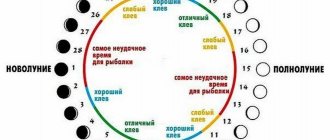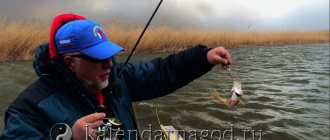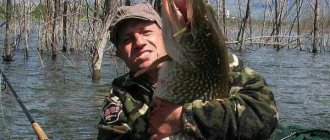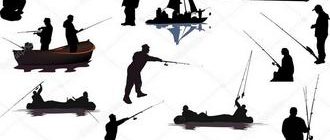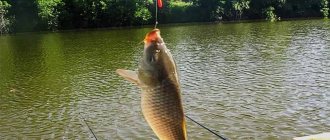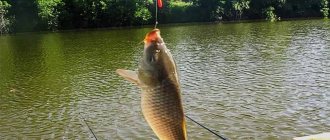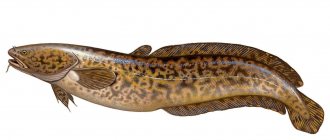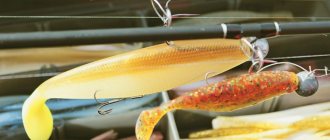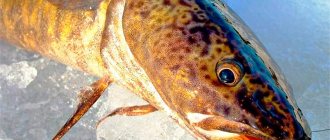Pike is one of the most popular predators and a coveted trophy for many anglers. It is a common catch, since this fish can be found in most domestic reservoirs, and its fishing is relevant throughout the year.
At different periods of the season, her behavior and lifestyle changes, which must be taken into account in order to get a good catch: a detailed calendar of the toothy predator’s biting will help in this matter.
Detailed pike biting calendar
The pike bite is influenced by a large number of different factors, including atmospheric pressure, wind speed, temperature, water purity and transparency. The calendar is universal, but it may contain small errors due to weather conditions in a particular year or the climate of individual regions.
The monthly bite forecasts are listed below:
- In January, the chances of a big catch are minimal, since the fish are at great depths and are characterized by passive behavior. During thaws, the chances of a bite increase significantly.
- In the first week of February the situation is the same as in January.
- In mid-to-late February, the chances of getting a bite are much higher.
- The beginning of March is a good period for pike fishing, especially in the southern regions and the middle zone, where the ice begins to melt; however, this predator activity is temporary.
- In the middle and end of March, the bite worsens and the pike becomes passive.
- In early April, the chances of biting are minimal. In the middle and end of the month, the likelihood of successful fishing increases if you choose the right bait.
- The whole of May is a favorable month for pike fishing; you can use any bait.
- Throughout June, a good bite remains, but it is necessary to monitor the movements of the predator in the reservoir in order to select the right places for fishing.
- In July, the bite worsens, especially in the southern regions, since hot weather makes the prey too passive.
- The chances of a bite in early August depend on the weather and air temperature; towards the end of the month the pike becomes active again.
- The whole of September is a very prosperous month for pike fishing, especially during the daytime. The approach of winter provokes zhor, the fish builds up fat before the onset of cold weather.
- In October, the normal bite continues, but it should be taken into account that the fish move further from the shore during this period.
- In the first half of November, the bite is usually the same as in October.
- In the second half of November it gets significantly colder, which negatively affects the activity of fish and the bite worsens.
- In December, the bite is usually quite good; if there are no sudden changes in temperature or weather changes, then pike can be found in shallow areas of reservoirs.
Weather and pike bite
Apart from the Moon, nothing good can be expected from any kind of “magnetic storms”. Pike, unlike humans, senses the approach of a magnetic storm several days before it begins. At this moment, she is actively feeding, perhaps trying to compensate for the upcoming pause in food intake. Pike also greedily takes the day before a sharp change in weather conditions: cold weather, prolonged bad weather, etc.
Pike weather can be considered cloudy or slightly clearing days with light winds from the south, west and north. A light drizzle on such days can only be helpful. Often, strong winds have a positive effect on pike biting, although it does cause some inconvenience to the spinning angler. As fishermen say: a strong wind drives the “toad” out of the reed thickets.
Steady atmospheric pressure or its decrease with low intensity also activates the pike. Repeatedly there has been a sharp spike in activity before a sudden deterioration in weather, especially before a thunderstorm.
In winter, a sharp drop in temperature by 10-15 degrees with a jump beyond -20°C is usually the worst indicator for pike fishing. A sunny day, and even with a strong east, northeast wind, also promises little good. However, stable weather, even at very low temperatures (below -20°C), is usually a very favorable factor. Thick clouds, thaw, light southern and western wind directions usually activate the pike, and a sharp rise in temperature by the same 10-15 degrees makes the pike “eat”!
In addition to weather factors, in most reservoirs the deterioration in pike biting is associated with a sharp change in water level. Water releases, which are often practiced in reservoirs, are an anomalous phenomenon; the fish react to this painfully and stop feeding within 1-2 days after the new level is set.
Lunar calendar of pike biting
The phases of the moon can also influence the behavior of a toothy predator; taking into account this feature, forecasts for biting each year are virtually the same:
- During the new moon, it is better to avoid fishing trips, since the likelihood of successfully catching a pike will be minimal.
- The first quarter is a much more successful period, during which the fish become more active and show interest in most of the baits used.
- During a full moon, it is recommended to pay attention to weather conditions, as they will have a more significant impact on prey behavior than the phase of the moon.
- During the last quarter, the predator becomes more aggressive, so this period can also be considered successful for fishing.
Should you trust the calendar?
Pike is common in many bodies of water, so its behavior and habits may vary in different regions. However, as practice shows, most biting calendars contain reliable information and can be trusted, although sometimes there are exceptional cases.
Most often they are associated with various natural disasters or abnormal weather: such factors can make a change in the usual way of life of a predator.
Which pike fishing calendar should I use?
When fishing for pike, you can rely on the lunar calendar or the standard calendar, in which bite forecasts are determined depending on the changing seasons and changes in weather conditions.
Both options are equally reliable, but it is important not to forget to take into account the individual characteristics of a particular reservoir, which determine the behavior of the prey, as well as the weather at a given time.
Fishing for pike in the spring
Success during spring fishing depends primarily on the climatic conditions of the region: in warm regions, where the ice begins to melt actively in early March, pike begins to bite the earliest and can be caught using spinning gear.
In March
March is a favorite month for many anglers who go to the reservoirs for pike. In this case, it is necessary to know and take into account the following features:
- The active bite persists only at the beginning of the month; at this time you can use both various artificial baits and live bait.
- Towards the middle or end of the month, the pike’s appetite disappears due to the approaching spawning. At this time, fishing bans begin to apply in many regions.
- The most promising places to search for a toothy predator are the borders of coastal thickets and clean, clear water, especially if fry of other fish live in these areas.
In April
Depending on the region, pike spawning begins at the very beginning of April or a little later, so in some reservoirs there is a chance of a good catch in the first week of the month.
It is necessary to remember about the bans on catching pike during the spawning period: their start and end dates vary for different rivers and reservoirs, so you should first check the current information.
For successful fishing, it is recommended to consider the following rules:
- In April, artificial baits with a noise effect are the most catchy, so you can use suitable models of wobblers, poppers or fairly large spinners. This is due to the cloudiness of the water in the middle or end of the month, which significantly impairs visibility and forces the fish to rely more on hearing rather than sight.
- It is better to look for pike in the same places where it spawned, since immediately after its completion it begins active hunting.
- It is best to choose small rivers or shallow areas of reservoirs for April fishing, since they warm up much faster, which has a positive effect on prey activity.
In May
May is an excellent month for pike fishing, especially for novice anglers, since the predator attacks virtually any bait.
During the feeding season you can get a very good catch, but the likelihood of catching trophy specimens at this time is minimal. It is only important to remember that in some regions a May ban on spinning fishing is being introduced.
Pike fishing in spring
At the beginning of spring, shortly before the opening of reservoirs, pike emerge from the depths and head towards the edges of the ice. gullies, mouths of rivers and streams, greedily pouncing on small fish. The first spring feeding of pike begins. Pike fishing in the spring, without exaggeration, is the most productive of the entire open water season. With the onset of the first days of March, even if most of the water is still covered with ice, the pike begins to actively feed.
Pike will attack literally anything: wobblers, twisters, vibrating tails, spinners and spoons, foam rubber, live fish, etc. The first days of March are ideal for replenishing your trophy pike collection. After all, this period is characterized not only by active biting. At the beginning of March, the largest, trophy pikes are caught, which will take a lot of effort to catch in the summer.
They start catching pike with a spinning rod literally immediately after the ice leaves the reservoir. It is especially convenient to catch pike even before the water begins to rise. One of the promising places for catching pike in the spring is a section of a reservoir where there is a border of clean water with algae. Therefore, if you find such a place, especially if you can see that a small fish is walking there, you should not pass by it.
Pike fishing in March
Golden time for winter fishing for predators with a spoon. Almost all types of winter baits work on the last ice. Spoons, balancers, blanks, large uralkas, cicadas, winter vertical wobblers, rattlins - everything is used. And the pike reciprocates. At the end of March, river beds are gradually freed from ice. The season for pike jigging has begun. In the south, the pike has already spawned, but in the north it has not even begun.
Pike fishing in April
The month of “troubled waters”. The flood is coming into its own. Pike fishing is effective only with noise baits. Jigs with petals, noise wobblers with active play, large spinners. It is these baits that have the greatest success with pike at this time.
Pike fishing in May
Water temperatures are rising everywhere. Grass is growing, fish fry are actively developing. Small pike are actively hunting. Large pike get sick after a period of changing teeth. This month saw the largest number of catches using spinners and active wobblers. The pike goes into the grass for forage fish.
We catch pike in the summer
The success of summer fishing depends mainly on the temperature, since on hot days all prey becomes passive and does not show any interest in hunting. Below, the fishing features are described in more detail by month.
In June
June is one of the best summer months for fishing, since the water has already warmed up well, there is no intense heat, and the predator continues to actively hunt and gain weight, and with the onset of summer, the May ban on spinning fishing is lifted.
Other features you need to know are as follows:
- The bite reaches its peak in the morning hours, the period from 5:00 to 8:00 is considered the most favorable.
- The prey goes to its permanent summer camps, so when visiting familiar bodies of water, finding it will not be difficult.
- If you are visiting a reservoir for the first time, it is recommended to look for a toothy predator in dense underwater thickets.
- The most effective are considered to be various models of artificial baits - wobblers or spinners.
In July
In July, the success of fishing will depend on the weather, since in extreme heat, large specimens stop hunting, and there is still a chance of catching only small pikes.
If you want to catch a large predator, you can try to use the largest models of walkers, since in this case the pike will try to drive the competitor out of its territory.
In August
In August, the situation in many reservoirs improves, as the water temperature gradually becomes lower and large predators become more active again.
This becomes especially noticeable closer to the middle of the month: you don’t have to bother yourself with searching for promising places or choosing bait; During this period, there is a lot of potential prey in reservoirs and pike are actively biting in virtually any area.
Pike fishing in summer
Many argue that catching a big pike in the summer is unrealistic. Not true! Even in hot weather (which lasts from one to three months in central Russia), the fish still feeds. And if it feeds, you can catch it. Where is the best place to catch pike in the summer? Pike, like many fish, strives for depth in hot weather; therefore, pike fishing is more successful in the shade of thickets or fallen trees, at the very bottom, near springs and in holes where the water is cooler.
If the reservoir is not deep, then shaded places - in thickets of reeds or grass - can serve as a suitable habitat for it. Due to the hot sun during the day, pike go hunting in the evening or early in the morning. So, the favorite places of pike in the summer are cool depths and shady places near trees and algae, which also serve as a place for them to ambush while waiting for prey. Start your fishing day as early as possible, with the first rays of the sun; the period between 5.00 and 8.00 am is the best time to catch pike.
Pike fishing in June
The grass at the bottom of the reservoirs has finally risen and is beginning to form grass islands. Pike occupy “summer apartments”—permanent camp sites in the summer. I’m starting to work again with summer “nickels”, from which I manage to remove 5-10 pike tails in one fishing trip.
Pike fishing in July
There is more and more grass in water bodies. The water temperature reaches its maximum. Small pike actively feed, reacting positively to any bait offered to it. Large pike behave depending on the temperature of the water in the reservoir. When the water temperature exceeds normal, large pike stop feeding. At this moment, she reacts only to huge baits, “driving” them out of her territory.
Pike fishing in August
The water temperature drops and pike activity increases. The pike season begins. In August, every fisherman becomes “a little bit of a spinning fisherman.” Even avid floaters, match fishermen and carp anglers at this moment, at least for one fishing trip, pick up a spinning rod. Pike can be caught everywhere, using any bait in any quantity.
Andrey Shalygin
Fishing for pike in the fall
Autumn is considered the most favorable period for catching pike, since it begins to eat, but its duration is much longer than in spring.
In September
September is a good month for fishing as the August fish activity continues. The secrets to getting an impressive catch are as follows:
- The predator actively builds up fat before winter, so it is recommended to use the largest models of wobblers or spinners; Artificial baits with a noise effect demonstrate a high degree of effectiveness.
- In September, pike remain in their summer camps; you should look for them in underwater thickets.
- In September there is a good chance of catching trophy specimens; you can catch them at great depths using a spinning rod or a float rod; It is best to cast from a boat.
In October
In October you can also count on a catch, but for this you should take into account the following changes:
- It is recommended to use only artificial baits, since it can be difficult to find sufficiently active and mobile live bait at this time of year.
- Pike continues to actively hunt, but at the same time it leaves its usual summer camps. You should look for it at great depths, away from the coastline and shallow areas.
In November
November is the most successful month for catching trophy specimens; the main secrets of successful fishing are discussed below:
- At the end of autumn, the main factor influencing the bite is the weather, so you should go fishing on cloudy and rainy days.
- The most effective bait for November fishing is vibrating tails or oscillating spoons; Sometimes blue or green balancers perform well.
- During the daytime, the probability of a bite is minimal; the predator is much more active in the late evening or early morning hours.
- It is best to look for prey near the bottom surface, where it feeds on dead fish.
Pike fishing in autumn
The most favorable time for pike fishing, of course, is autumn. After the summer heat has subsided and before the ice sets in, the predator begins to actively hunt and eat. The autumn pike feeding begins, which, unlike the spring pre-spawning and summer post-spawning, is long-lasting and quite stable. At the same time, pike bite best in the fall at spring and autumn dawns, with the intensity of the bite shifting to the morning.
If we look at the calendar, all these phenomena begin with the beginning of the water cooling in September, increase in October and reach their peak in November, before freeze-up.
November is characterized by the fact that just before the formation of ice, the real pike feeding begins, which is called “pre-winter”. The first banks are already appearing, and open water fishing is becoming truly trophy. In autumn, pike often sits under snags and islands with reeds; pike fishing in autumn is carried out at great depths.
Although, the most likely depth for catching large pike is no more than one and a half to two meters deep. If you are lucky, then from such a relatively shallow depth you can pull out a specimen weighing 10-12 kg.
Pike fishing in September
A leaf flew from a birch tree. The hunting season for large pike opens. The most catchy species is catching pike with a jig. The sizes of any baits used are many times larger than those used in spring and summer. In warm September, pike fishing can take place in its favorite summer places.
At the edge of the grass, you can catch decent grass pike using small wobblers and spoons. For trophy pike, you should go closer to the depths, to channel edges and dumps, to exits from pits, closer to deep-sea snags and flooded forests on reservoirs. At the depths, pike fishing in September usually occurs from a boat.
Fishing methods depend on the chosen body of water. In almost any body of water, a spinning rod, a float rod, mugs and a track can be successfully used.
Pike fishing in October
The best month for a spinner. The predator, following the forage fish, moves to deeper places. There are no more bites on the summer spots; they are empty. But on the echo sounder you can see how characteristic predatory “crescents” take their positions on all channel edges, slopes, and slopes of underwater mounds.
Any type of fishing brings results - trolling, jigging, fishing with large spoons and spinners along the bottom. In October, pike can be caught on almost anything shiny and moving.
You can catch pike in October with live bait, but in the fall it is not so easy to get good moving live bait, so the best option is large wobblers or lures for pike, all about 10-12 centimeters long. The best option for lures for pike: Norway, Baikal, cascade, spoon, success. But do not forget that each reservoir has its own laws and pike fishing may differ even in neighboring reservoirs.
Pike fishing in November
The weather is deteriorating and the water temperature is dropping.
In that pre-winter time there is a chance to catch the largest, trophy specimens. The main thing is to get to the pond in “pike weather”. When it rains, winds, ripples and is cold.
You can catch pike in November using almost any bait.
It is best to use a spinner spoon; it is in November that you can get the greatest catch with it.
You can use a vibrating tail. But fishing with live bait does not guarantee results. Catching pike in November with dead fish can be very fruitful, and this is due to the fact that pike feed on such fish from the bottom in November.
You can catch pike in November using regular spoons and fairly large balancers: green, yellow or white. The pike does not pay attention to silver balancers at all, but you can still catch fish with red-copper balancers. The best time to catch pike in November is early morning. It is best to start fishing at dawn. During the day, pike hardly bite, but you can try fishing in the evening, before sunset.
Fishing for pike in winter
In winter, the activity of pike decreases significantly, but many people still go to water bodies for it, since, unlike most other popular breeds, it does not hibernate.
December
In December, changes in the behavior of the prey are very noticeable: it hunts less and does not gather in schools, so even catching one pike does not guarantee that a promising fishing spot has been discovered
During this month, you should avoid days when the weather changes or the air temperature drops sharply; Fishing on the first ice is considered the most successful.
In January
In January, many anglers go to reservoirs, but catching pike will require a lot of effort. This is the most unfavorable winter month for fishing; the chance of a catch increases only during a thaw, when the predator experiences a short-term increase in interest in hunting.
Special winter models of spinners are considered the most successful bait; fishing with the help of girders is also promising.
In February
In February, pike gradually become more active as they sense the end of winter and the approaching warmth of spring. More and more people start going fishing this month; you can continue to use lures or catch a predator with spoons, but the chance of a bite also increases when using live bait.
When studying the biting calendar, you can understand that the probability of catching pike with proper preparation is present throughout the year. It is best for beginners to go fishing in May-June or August-September, when the predator is most active.
Gradually gaining experience, you can move on to catching a toothy predator at other times of the year, when this process will be more complex, but no less interesting and exciting.
